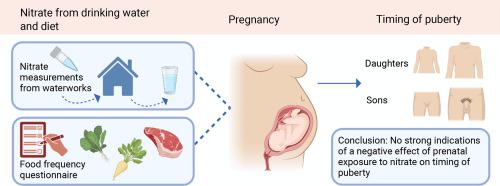Environment International ( IF 10.3 ) Pub Date : 2022-11-24 , DOI: 10.1016/j.envint.2022.107659 Pernille Jul Clemmensen 1 , Nis Brix 2 , Jörg Schullehner 3 , Lea Lykke Harrits Lunddorf 1 , Andreas Ernst 1 , Ninna Hinchely Ebdrup 4 , Anne Ahrendt Bjerregaard 5 , Birgitte Hansen 6 , Leslie Thomas Stayner 7 , Thorhallur Ingi Halldorsson 8 , Sjurdur Frodi Olsen 9 , Torben Sigsgaard 10 , Henrik Albert Kolstad 11 , Cecilia Høst Ramlau-Hansen 1

|
Background
In Western countries, age at pubertal development has declined during the last century in girls, and probably also in boys. No studies have investigated whether nitrate, a widespread environmental exposure with teratogenic and hormone disrupting properties, might affect timing of puberty.
Objectives
We investigated if prenatal exposure to nitrate from drinking water and diet was associated with timing of puberty.
Methods
This cohort study included 15,819 children born from 2000 to 2003 within the Danish National Birth Cohort. Self-reported information on current status of various pubertal milestones was provided every six months by a questionnaire from 11 years of age until 18 years or full maturity, whichever came first. Maternal nitrate intake from diet (mg/day) was derived from a mid-pregnancy food frequency questionnaire and individual level nitrate exposure from drinking water (mg/L) was derived using measurements from Danish public waterworks. Adjusted average differences in months in age at attaining several pubertal milestones as well as the average age difference in age at attaining all the milestones were estimated separately for diet and water using a regression model for interval-censored data. C- and E-vitamin, red meat and processed meat intake were explored as potential effect modifiers in sub-analyses.
Results
No strong associations were observed between prenatal exposure to nitrate and timing of puberty in children. However, sons born of mothers with a nitrate concentration in drinking water at their residential address of >25 mg/L (half of the World Health Organisation (WHO) guideline value) compared with ≤1 mg/L showed a tendency towards earlier age at pubertal development with an average age difference of -1.2 months (95% confidence interval,-3.0;0.6) for all the pubertal milestones combined.
Discussion
Studies including more highly exposed children are needed before the current WHO drinking water guideline value for nitrate can be considered safe concerning pubertal development.
中文翻译:

产前饮食和饮用水中的硝酸盐暴露以及儿子和女儿的青春期时间:一项全国队列研究
背景
在西方国家,女孩的青春期发育年龄在上个世纪有所下降,男孩也可能如此。没有研究调查硝酸盐这种具有致畸和激素干扰特性的广泛环境暴露是否会影响青春期的时间。
目标
我们调查了产前从饮用水和饮食中接触硝酸盐是否与青春期时间有关。
方法
该队列研究包括 2000 年至 2003 年出生的丹麦国家出生队列中的 15,819 名儿童。从 11 岁到 18 岁或完全成熟,以先到者为准,每六个月通过一份问卷提供有关各种青春期里程碑当前状态的自我报告信息。母亲从饮食中摄入的硝酸盐(毫克/天)来自于妊娠中期的食物频率问卷,而来自饮用水的个体硝酸盐暴露水平(毫克/升)是使用丹麦公共自来水厂的测量值得出的。使用间隔删失数据的回归模型分别估计饮食和水在达到几个青春期里程碑时的调整平均年龄差异以及达到所有里程碑时的平均年龄差异。C 和 E 维生素,
结果
未观察到产前硝酸盐暴露与儿童青春期时间之间存在强烈关联。然而,与≤1 mg/L 相比,居住地址饮用水中硝酸盐浓度 >25 mg/L(世界卫生组织 (WHO) 准则值的一半)的母亲所生的儿子在所有青春期里程碑的总和平均年龄差异为 -1.2 个月(95% 置信区间,-3.0;0.6)。
讨论
在当前的 WHO 饮用水硝酸盐指南值被认为对青春期发育安全之前,需要对更多暴露于高暴露儿童进行研究。











































 京公网安备 11010802027423号
京公网安备 11010802027423号